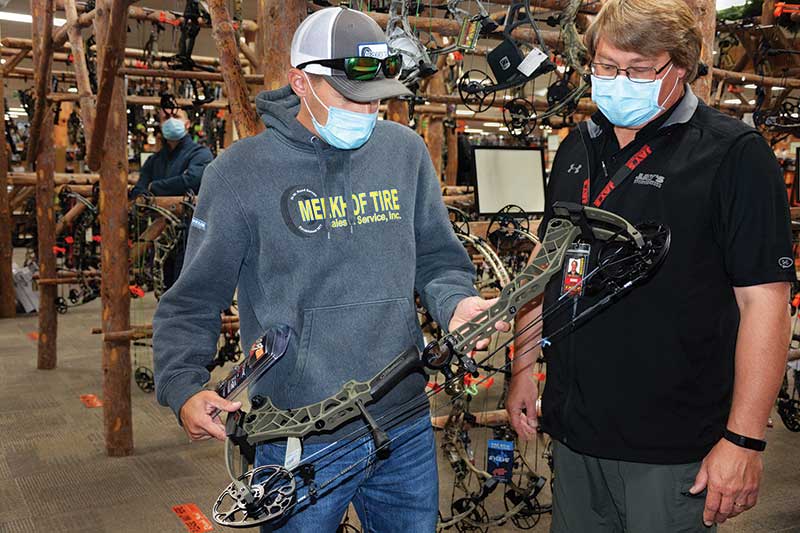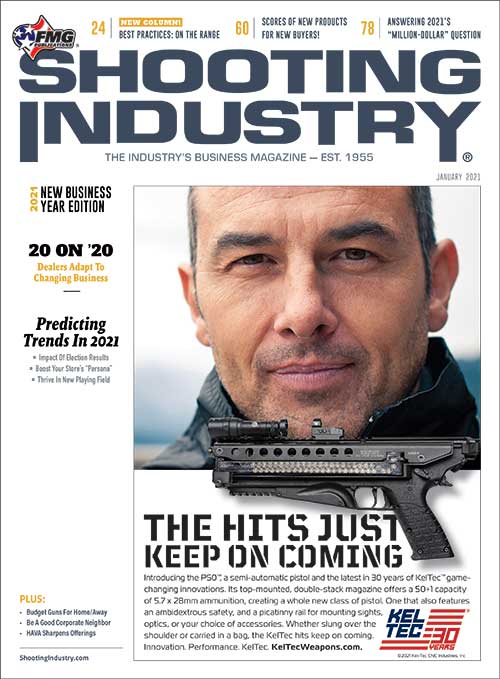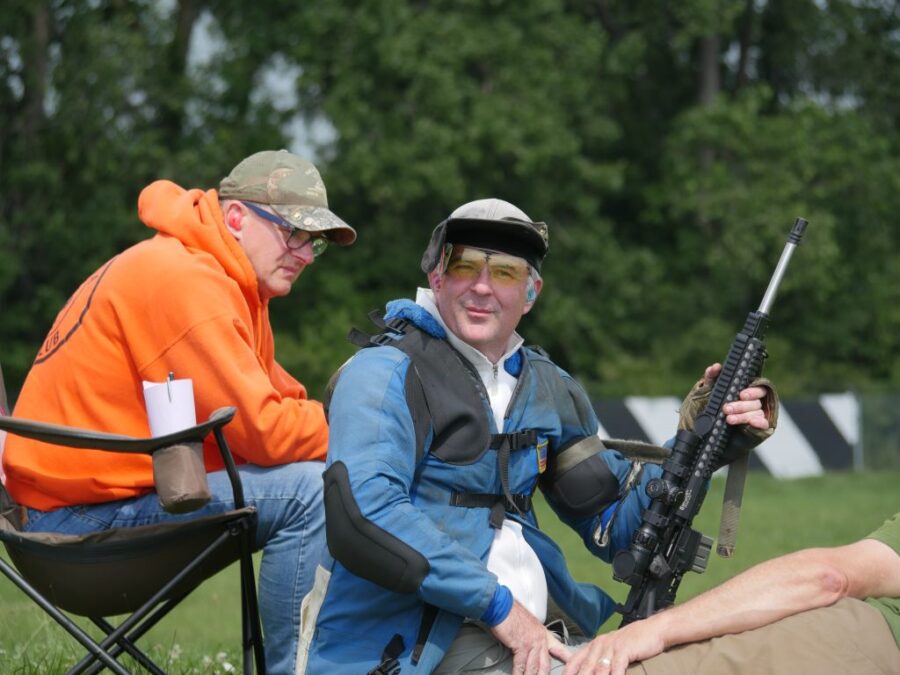“Our first course of action was to reduce our hours to accommodate some form of business,” Copeland shared. “We also offered every employee, regardless of tenure, two full weeks of COVID personal time off. One, to ease their minds and, secondly, with the caveat if it wasn’t used, we would pay it out in the November payroll as an incentive to stay working.”
Four days later, though, most businesses deemed nonessential were ordered closed. Firearms were not considered essential in Michigan.
“Because we sell dog food, MREs and some other essentials, we contemplated staying open with even more restrictions, but in the end the health and well-being of our staff was far more important than putting a couple dollars in the till,” Copeland recalled.
Manufacturers and distributors were also affected with staffing issues.
Justin Gorman, director of sales for Kinsey’s Inc., said they first looked at employee reductions but then faced an immediate need to ramp up as demand for certain products surged.
“Kinsey’s never had work-from-home positions until the pandemic occurred. We were nervous about how we could handle it, but I have been pleasantly surprised by our ability to adapt and change as needed,” Gorman said.
A New Playing Field
Strategizing For 2021 Success After Chaotic 2020
While 2020 was a chaotic year for firearms and sporting goods retailers, the unknowns heading into 2021 are creating consternation on multiple fronts.
Impacts Made, Changes Felt
Larry Hyatt, owner of Hyatt Gun Shop in Charlotte, N.C., shared pandemic concerns largely paled in late 2020 compared to concerns about the November elections and persistent violence in the streets of many cities, including Charlotte.
“It’s a tough time to be in the gun business,” Hyatt said, even though sales were incredibly brisk the weeks before the election. “June and July have always been our slowest months, and that’s across 61 years of being in business. This year, they were our busiest.”
To look ahead, one needs to look back at impacts and changes already felt and made.
Like many retailers, Hyatt was placing big orders throughout summer and fall. Manufacturers struggled to fill them, with some orders seeing just 10% fulfillment. Keeping customers happy was a challenge, Hyatt said.
In Gaylord Mich., Jay’s Sporting Goods saw firearms and ammunition sales increase significantly as coronavirus shutdowns began. Store Director Mark Copeland shared the increase was so heavy the store began shutting down National Instant Criminal Background Checks hours before closing due to the backlog of waiting purchasers.
Adapt!
This run on guns happened as uncertainty reigned over how to operate in an ever-changing environment.
Copeland initially worried not only about customers, but also his staff. The store sees hundreds of shoppers daily coming from throughout the Midwest. As COVID cases began to mount, Jay’s began losing employees who were concerned about exposure while working.
Hyatt said fears about exposure to the coronavirus caused him to lose about one-third of his older, more experienced work force.
“They had underlying conditions and didn’t want the added risk,” he explained. “We thought the virus would be over.”
Both stores adjusted.
“Fortunately, we were deemed an essential business in North Carolina and could stay open. We learned how to deal with the masking, the need to wipe things down, everything. We learned,” Hyatt noted.
“There was no playbook for this scenario. If this has taught us anything, it’s you need to be prepared to adapt and change in a moment’s notice.”
Justin Gorman Director of Sales, Kinsey’s Inc.
Social Distance Tweaks
Eventually, Jay’s Sporting Goods was able operate like many businesses deemed essential nationwide — taking appointments, offering curbside pickups, limiting in-store patrons and enhancing safety and sanitation procedures. Employees had to daily certify they didn’t have COVID symptoms or a fever.
“People have so much fear and uncertainty right now they need reassurance good people exist and we value them as family.”
Mark Copeland Store Director, Jay’s Sporting Goods
“We invested thousands of dollars in personal protective equipment, plexiglass barriers and signage. We re-merchandized our store to accommodate minimum social distancing guidelines, completely modifying everyday procedures from checkout to breakroom,” Copeland relayed.
Due to restrictions on how many people could be in a store at one time, Hyatt saw long lines of customers waiting to get in. He arranged for a food truck to stay near the store entrance. If people had to wait to shop, at least they could stay fed and hydrated.
Supply Chain In Flux
Retailer planning for 2021 is fraught with unknowns.
For example, Hyatt asked, “How do we order? Is it based on the party that gets elected and how things might change? Plus, we may still have concerns over looting and burning if Trump is reelected. There are many concerns for a retail gun dealer between the pandemic, the election and the violence.”
Hyatt bemoaned 2020 inventory shortages, explaining phone calls between dealers and others working deals were constant as people sought to satisfy a customer demand.
“It’s tough to keep customers happy, but we can’t control the manufacturing,” he said.
Gorman bluntly stated, “Forecasting went out the window in March and April. Nobody can forecast the rapid surge in demand our industry is seeing. If such forecasting were possible, the supply chain would not be as lean as it is right now. I would rather have this problem than the lack of demand, but it’s equally challenging.”
Who will get the guns could be a defining issue in terms of business success in 2021.
One firearms manufacturer confidentially told me if production shortages occur, the retailers who will likely get orders filled first are those with partnership agreements. Complete independents may see considerable delays in getting ordered product into the hands of customers.
One thing Hyatt learned to control was ammunition sales, limiting individual customer purchases to one or two boxes. Copeland did the same at Jay’s. Without the limits, some people would buy out most of the available stock.
Mostly bare shelves would be totally bare shelves.
“We learned to start rationing,” Hyatt informed.
By late summer, Copeland was dealing with major shortages of centerfire ammunition, firearms and general merchandise.
The crazy thing is even with over 50% reduction of on-hand inventory compared to 2019, our sales couldn’t be better. There seems to be no shortage of cash in the customer’s pocket,” Copeland said.
Gorman revealed acquiring inventory was the priority heading into the end of 2020. “The supply chain is dry right now. We’re allocating almost all of our FFL inventory, as are many distributors. If we can get it, we can sell it,” he said.
Now Adapt More!
Figuring out 2021 strategies to deal with a “new normal” is a challenge.
Kinsey’s is forecasting 2021 to remain strong even if there is a coronavirus vaccine available, Gorman added, noting, “Retailers will need to resupply when the surge ends, whenever it may be.”
Copeland said Jay’s will maintain current procedures and continue to operate one shift daily, opening at 10 a.m. and closing at 6 p.m. He expects curbside service to remain in play, as well as taking appointments for consumers unwilling to enter the store.
“We’ve heard a lot of, ‘We don’t have a gun in the house, but think it’s time we need one.’”
Larry Hyatt Owner, Hyatt Gun Shop
Both Hyatt and Copeland said they will place continued emphasis on adhering to required health and sanitation protocols. Copeland has arranged for a company to respond quickly to sanitize the entire location after hours should a positive COVID case be documented.
Copeland says a positive attitude is the best way to “elevate” the customer experience in these rough times.
“It starts with me, each day,” Copeland stated. “People have so much fear and uncertainty right now they need reassurance good people exist and we value them as family. Everything we sell is to enhance the outdoor experience in some way and if you can’t have ‘fun’ selling ‘fun,’ you might need an extra day or two off.”
Online Sales Boon
Gorman said online sales “rocketed” from the earliest stages of the pandemic. This includes firearms and accessories.
“Consumers never stopped buying. When many retailers were forced to close, online was the only option. As brick-and-mortar retailers have reopened their doors, we have seen consumers shift their purchases back to independent retail shops,” Gorman observed.
“In our industry,” he continued, “consumers still want to touch and feel most of the products before making a purchase. Although it is wise for retailers to have an online presence, there is no substitute for in-store customer interactions.”
Hyatt said he loves online sales because they usually deliver better profit margins, but adds there is nothing like a retail sale in an actual store to drive the sale of accessories. His store’s online sales soared during the first two months of the pandemic until inventory began depleting as manufacturers couldn’t keep pace.
Any Silver Linings?
One offshoot of the pandemic and other fears in America is a bow wave of new customers.
“We’ve had many people who never bought a gun before come in, including many women, African Americans and people in the suburbs. We’ve heard a lot of, ‘We don’t have a gun in the house, but think it’s time we need one.’ People were generally afraid our institutions wouldn’t be able to cope with the pandemic. You know, you dial 911 and no one comes,” Hyatt said.
Gorman said Kinsey’s saw some non-firearms dealers inquire about the process of getting an FFL. (In many states, gun stores were deemed essential and they could remain open if they followed guidelines. Holding an FFL provided some business protection.)
Copeland said trade associations stepped up with tips and tricks to beat the new normal. He also believes the stay-at-home orders gave the outdoor industry a needed boost.
“I see more people recreating locally. We may see the COVID generation spending more and more time in the safest environment possible and that is outdoors,” Copeland said. “There was no playbook for this scenario,” Gorman said.
“If this has taught us anything,” he added, “it’s you need to be prepared to adapt and change in a moment’s notice. I believe those who were able to adapt to the challenges quickly are more than likely coming through the pandemic stronger than they were before it began.”






